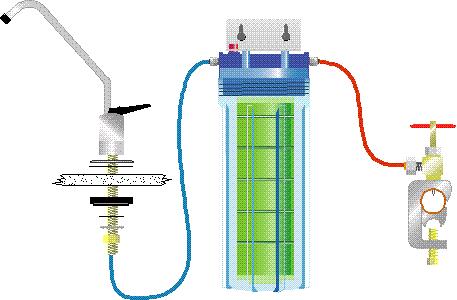Can I Install a Water Filter at Home?
In a world where access to clean and safe drinking water is paramount, installing a water filter at home has become a popular choice for many households. The need for purified water goes beyond quenching your thirst; it’s about ensuring the health and well-being of your loved ones. In this article, we will explore the process of installing a water filter at home, from the types of filters available to the benefits they offer and the installation steps. Let’s dive in!

Understanding the Need for a Water Filter
Why is Water Filtration Necessary?
Before delving into the installation process, it’s crucial to understand why water filtration is necessary. Tap water can contain impurities, such as sediment, chlorine, lead, and other contaminants. These substances, while typically at safe levels, can still impact the taste, odor, and overall quality of your drinking water.
Health Benefits of Filtered Water
Filtered water not only tastes better but also offers health benefits. Removing harmful chemicals and contaminants ensures that you and your family are consuming clean and safe water. This can lead to better overall plumber health and reduce the risk of waterborne illnesses.
Types of Water Filters
1. Pitcher Filters
Pitcher filters are a simple and affordable option. They use activated carbon to remove impurities and improve taste. However, they are best suited for small quantities of water.
2. Faucet-Mounted Filters
Faucet-mounted filters are easy to install and provide filtered water directly from your tap. They are suitable for those who need a convenient and cost-effective solution.
3. Under-Sink Filters
Under-sink filters are installed beneath your kitchen sink and provide a continuous supply of filtered water. They are more effective at removing contaminants but require professional installation by plumbers Bristol.
4. Whole-House Filtration Systems
Whole-house filtration systems treat all the water entering your home. They are the most comprehensive option, ensuring that every water source in your house delivers clean, filtered water.
Installation Steps
1. Determine the Filter Type
The first step is to choose the right water filter for your needs. Consider your budget, the level of filtration required, and the available space for installation.
2. Gather the Necessary Tools
Depending on the type of filter you choose, you may need tools such as wrenches, screws, or a drill.
3. Locate the Installation Point
Identify the optimal location for your filter. For faucet-mounted filters, this would be the kitchen sink. For under-sink and whole-house systems, choose a suitable spot near your water supply lines.
4. Turn Off Water Supply
Before installation, turn off the main water supply to ensure safety and prevent water leakage.
5. Install the Filter
Follow the manufacturer’s instructions to install the filter, ensuring a secure and leak-free connection.
6. Test the System
After installation, flush the system according to the manufacturer’s recommendations to remove any air or contaminants.
7. Regular Maintenance
Remember to replace filter cartridges as instructed to maintain the effectiveness of your water filtration system.
Benefits of Home Water Filters
1. Improved Water Quality
A water filter significantly improves the taste and odor of tap water, making it more palatable for drinking and cooking.
2. Healthier Lifestyle
Filtered water reduces exposure to harmful contaminants, leading to better health outcomes for you and your family.
3. Cost Savings
Investing in a water filter can lead to long-term cost savings compared to purchasing bottled water.
Installing a water filter at home is a practical and wise decision. It not only enhances the quality and taste of your drinking water but also contributes to your family’s health and well-being. With various filter options available, you can choose the one that best suits your needs and budget. So why wait? Take the first step towards cleaner, healthier water today.
FAQs (Frequently Asked Questions)
1. Can I install a water filter myself?
Yes, you can install certain types of water filters, such as pitcher filters or faucet-mounted filters, yourself. However, for more complex systems like under-sink or whole-house filters, professional installation is recommended.
2. How often should I replace the filter cartridge?
The frequency of filter cartridge replacement depends on the type of filter and the manufacturer’s recommendations. Typically, it ranges from every two to six months.
3. Are water filters expensive to maintain?
The cost of maintaining a water filter varies depending on the type and brand. However, it is generally more cost-effective than buying bottled water regularly.
4. Do water filters remove all contaminants?
Water filters are effective at removing a wide range of contaminants, but the specific contaminants removed depend on the type of filter. It’s essential to choose a filter that meets your water quality needs.
5. Are whole-house filtration systems worth the investment?
Whole-house filtration systems offer comprehensive water treatment for your entire home. If you prioritize purified water throughout your household, they can be a worthwhile investment in the long run.
